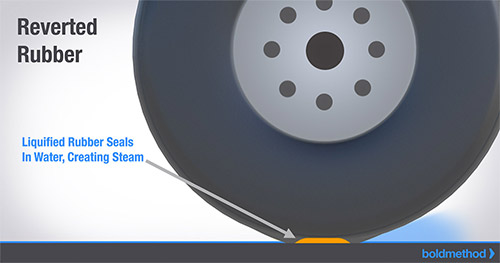As the wheel rolls along a wet
runway, it is constantly squeezing the water from the tread. This squeezing action generates water pressures which can lift portions of the wheel off the runway and reduce the amount of friction the wheel can develop.
This action is called hydroplaning, so technically, whenever a Wheel is moving on a wet surface, it is hydroplaning.
This results in wheel-to-ground
friction which can be low at high speeds and improve as speed reduces.
Water and snow have a great impact on landing performance. The landing distances are based on dry conditions and test pilot skills. Regardless of how good the conditions are, you should not
attempt to land at a runway that is as short as the published takeoff and landing distances.
Any water (heavy rain showers), snow or slush can and will have an adverse effect on the landing distance and the danger of hydroplaning (with no wheel braking and loss of directional control) is very real and has led to loss of life in the past already.
There are three types of
hydroplaning : Viscous, Dynamic and Reverted rubber
Viscous hydroplaning occurs on all wet runways and is a
technical term used to describe the normal slipperiness or lubricating action of the the water - While viscous hydroplaning does reduce the friction it is not to such a low level that the wheel cannot be spun up shortly after touchdown to initiate the antiskid system.
Viscous hydroplaning is the most commonly encountered cause of low friction on wet runways, and occurrences are often mistaken for dynamic hydroplaning.
How To Prevent Viscous Hydroplaning Land on a grooved runway, if possible.
1. Don't land fast.
2. Keep your wheels inflated. Under-inflated wheels hydroplane easier than properly inflated ones.
3. Use back pressure and aerodynamic braking to slow down, and use light brake pressure.
Dynamic Hydroplaning.
Dynamic hydroplaning is the
technical term for what is
commonly called hydroplaning.
During total dynamic hydroplaning the wheels lifts off the pavement and rides on a wedge of water like a water ski. Because the conditions required to initiate and sustain it are extreme, it is a phenomenon that is rarely encountered.
However, when dynamic
hydroplaning occurs it lifts the
Wheels completely off the runway and causes such a substantial loss of tire friction that wheel spin up may not occur.
The conditions required to cause dynamic hydroplaning are high speed, standing water and poor surface macrotexture. These conditions must continue without interruption to keep the wheels on its plane. In the absence of any of these conditions, dynamic hydroplaning will either not occur at all or will affect only a portion of the wheel footprint.
How To Prevent Dynamic Hydroplaning
1. Don't land fast on a wet runway. Dynamic hydroplaning happens at
about 8.6 times the square root of your Wheel pressure. For a Cessna 172 with 42 PSI tires, that's about 56 knots.
2. Keep your Wheel inflated. Under-inflated Wheels hydroplane easier than properly inflated ones.
3. Use back pressure and aerodynamic braking to slow down. The more weight you have on your Wheels, the better.
Reverted rubber hydroplaning
can occur whenever a locked wheel is skidded along a very wet or icy runway for a time long enough to generate frictional heat in the footprint area.
Reverted rubber hydroplaning can be initiated at any speed above about 20 knots and results in Wheel friction levels comparable to that of icy runways.
How To Prevent Reverted Rubber Hydroplaning
1. Use light brake pressure, and use aerodynamic braking to keep maximum weight on your landing gear.
2. Use light brake pressure, and never lock up your brakes on landing.
Note: Use these anti-hydroplaning techniques the next time you're landing in the rain, and you'll handle any wet runway like a pro.




No comments:
Post a Comment